Spider-view: "The Three Faces of Evil"
A basic story is constructed upon two strong pillars: powerful connections to recent Spidey history and the impressive work of penciler Mark Bagley
—by Nathan on May 8, 2023—
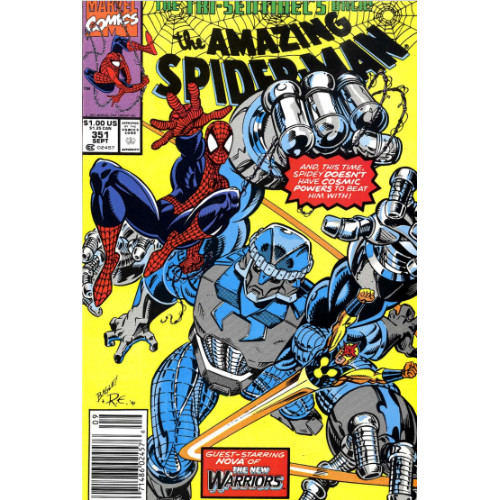
You thought we were finished with that whole pesky “rogue vibranium” situation two "Spider-view" posts ago, didn’t you? So did I. You figured all that stuff got tossed by Iron Man into the bottom of a molten subterranean river where it couldn’t harm nobody, right? So did I.
Well, too bad. We were both wrong.
Y’see, while we were mixing it up with Venom, the Avengers, and Freedom “We’re actually the Brotherhood of Evil Mutants but with a different name” Force in the last post, this synthetic vibranium created by Roxxon wasn’t completely destroyed…which is a problem. Unlike its genuine predecessor, synthetic vibranium eventually decays into Antarctic vibranium, a special version of the metal discovered only in the Savage Land that melts whatever it touches. Completely fits into the ever-widening “dangerous if it falls into the wrong hands” category within the Marvel Universe. Always new weapons, elements, magic totems, or objects to find lying around the world.
And, speaking of hands, we’ve got a baddie with six of ‘em. No, not some knockoff amputee Doctor Octopus. This guy’s a bit bigger. With eyes, literally, in the back of his head. And his second head. And his third.
“The Three Faces of Evil”
Writer: David Michelinie
Penciler: Mark Bagley
Inkers: Randy Emberlin, Sam de la Rosa
Colorist: Bob Sharen
Letterer: Rick Parker
Issues: Amazing Spider-Man #351-352
Publication Dates: September 1991-October 1991
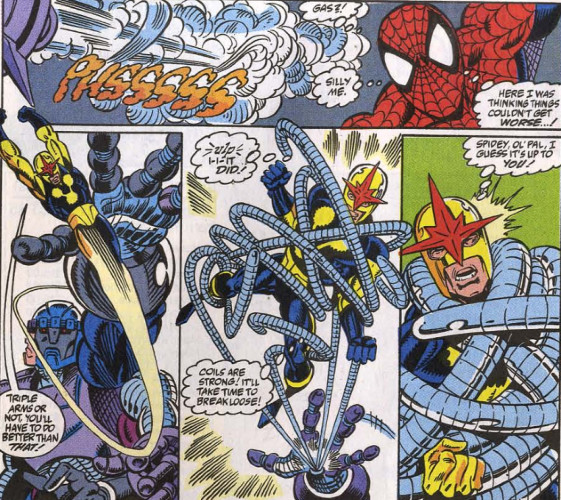
Arise, Tri-Sentinel! Arise!
Last we saw this metallic mammoth, it was plodding its way towards a New York nuclear plant when Spidey, endowed with the powers of Captain Universe, blew it to bits. Our hero’s Herculean efforts left him sapped of his cosmic capabilities, the Enigma Force no longer needed for the purpose it bestowed the power on him in the first place.
Maybe it shoulda stuck around a little longer.
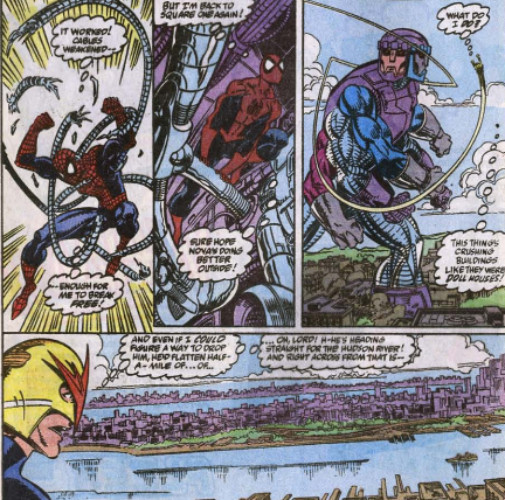
Michelinie cleverly unites two of his most recent stories in this two-part tale, and if there’s one thing I adore about comic book continuity, it's when writers effortlessly fuse pieces of history together, whether recent or primordial (in a very relative sense). Even smallish details tickle me red-and-blue, like Doctor Doom and Titania referencing her Secret Wars origins or Chris Claremont having Jean Grey decimate an alien race Stan Lee introduced an emissary of in the same Avengers issue he defrosted Captain America. So to have an entire story predicated on past events, especially when those prior events didn’t naturally set up a sequel, makes me happy.
Don’t get me wrong, writers can set themselves up for sequels through foreshadowing and epilogues decently well; on the other hand, writers who pull from past events can sometimes awkwardly claim the narrative always meant to draw from those elements without ever meaning to have that happen. Look no further than Cloak and Dagger’s tangled history to see where writers inserted new story elements to try and re-frame older narratives (did C&D gain powers as gangland drug trial guinea pigs or did those drugs awaken inherent mutant abilities?). And in an industry where dozens of writers and artists contribute to dozens of characters, the melding of previous and present plots can be iffy at best sometimes.
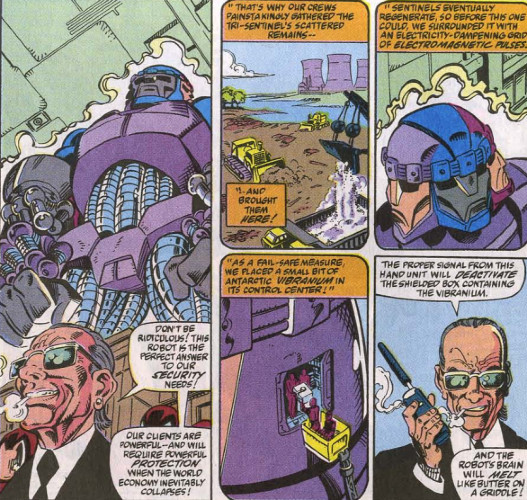
Fortunately, probably because Michelinie wrote the aforementioned and current Spidey plots, the pieces fit together to form a satisfying puzzle. Michelinie reintroduces the concept of Antarctic vibranium fluidly, not necessarily picking up from where he left the annuals but allowing the element to reappear without feeling forced. Likewise, the Tri-Sentinel’s reappearance feels natural to the narrative being told–reconstructed by the sinister Life Foundation (an organization of underground-dwelling doomsday preppers), the behemoth feels appropriately menacing; not that it was a pushover when facing Enigma-powered Spidey, but now that the Web-Head can’t cut loose, the Tri-Sentinel poses a greater threat.
Past these elements, however, much of the plot feels strictly paint-by-numbers. Teamed with Nova for these issues, Spidey finds himself at odds with the Tri-Sentinel and its handlers. The narrative unravels kinda the way you’d expect: our heroes stumble upon a nefarious plot in motion, secretly break into a high-security facility, and quickly run afoul of their foes once they’re recognized. The second issue, specifically, feels like it lifts its general plot from the previous Spidey/Tri-Sentinel tussle. A couple of ideas are tossed in to make it feel a tad different, but when Spidey and Nova have to keep the big guy from approaching yet another New York nuclear power plant, the endgame drifts into familiar waters.
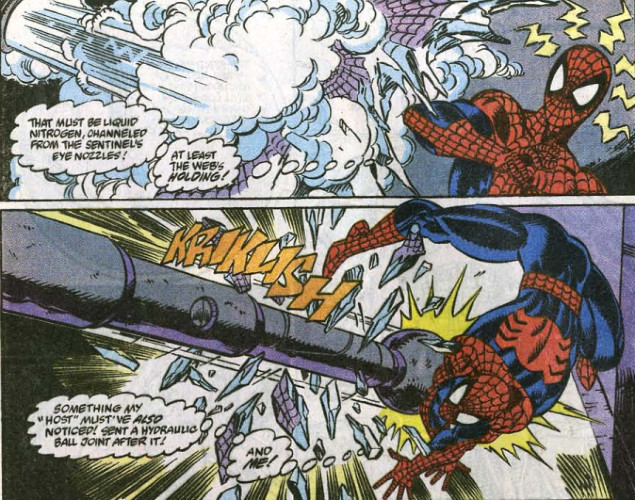
Michelinie certainly does what he can to inject creativity into the story. Perhaps his most thrilling sequence sees Spidey navigating the Tri-Sentinel’s innards, harrowing-ly hopscotch-ing his way past internal defenses like randomly fired rivets, knockout gas, coils, and liquid nitrogen. Meanwhile, Nova attacks from the outside, facing external threats and angry, well-armed doomsday preppers. But most of this feels standard.
What I wish Michelinie had done was play with more of the Spidey/Nova partnership in the narrative. Pieces of characterization exist–when first facing the preppers, the heroes’ arrogance puts them in each other’s way, foiling their individual efforts. The two later team up more successfully, leading Nova to realize the continually important lesson of trusting other people…and, heck, maybe even making some friends outside the New Warriors. It’s a decent sentiment, sure, but it’s an oft-repeated one in comic book narratives. This feels little different from Spidey telling the Punisher not to kill people or Spidey forming a quasi-alliance with anti-hero Cardiac, on his toes around a character whose methods differ from his straight-arrow tendencies.
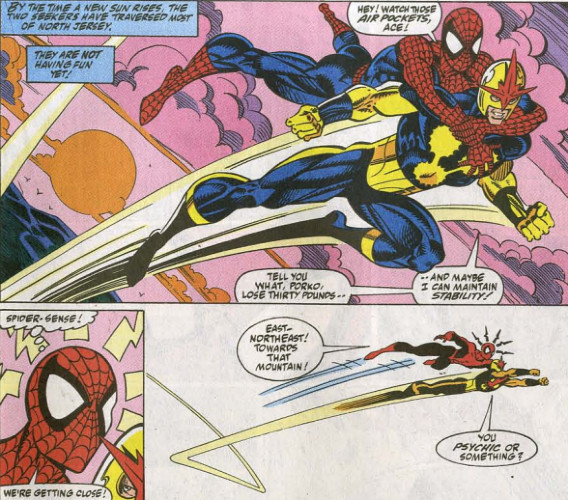
And maybe, I’ll admit, I’m asking for too much. Michelinie’s “team up” isn’t preceded by the same level of consistent bickering between heroes we may brush up against in other stories. Spidey and Nova don’t bump heads as often as Spidey would with a guy like the Punisher or even Cardiac. I’m not overly familiar with Nova; this is, I believe, the Richard Rider version of the character, who’s been around since the 70s. He’s not a kid, Marvel’s wonky chronology notwithstanding. Guy’s got some more experience under his belt than a doctor-turned-vigilante. Which may explain why he isn’t as hot-headed as some of Spidey’s other recent sparring partners. But it does lend the ending panels their forced sentimentality, Nova shaking Spidey’s hand before (presumably) rocketing off into the sunset.
Before we close, I must mention the true hero of our story: Mark Bagley. Touted on #351’s splash page as ASM’s “new regular penciler,” Bagley follows on the heels of notable artists such as Erik Larsen and Todd McFarlane. We’ve witnessed Bagley’s unique style previously, on crossover arcs such as “Atlantis Attacks” and “The Evolutionary War,” as well as his official ASM debut during the second half of the two-part “Cardiac” chronicle. Bagley’s work doesn’t seem quite as refined here as it would be in later 90s ASM issues and Ultimate Spider-Man, but still, it’s a mostly recognizable style. It’s fun seeing Bagley take on the title at a time where he was still tweaking his trademark artistic abilities; I’m reminded of John Romita Jr. on “Nothing Can Stop the Juggernaut” or even the original Contest of Champions, two stories where fans can easily compare the artist’s earlier work to his more current style.

This two-parter isn’t anything grand. It’s your basic, average team-up tale. It sports some fun sequences and a couple of moments entrenched in recent continuity. Honestly, those nods to recent Spidey narratives probably elevates this tale just a smidge–I’m genuinely a sucker for references and stories purposefully built atop prior tales. So thumbs-up to Michelinie for pulling in those previously placed plot points, and of course, a thumbs-up to Bagley for warming us up for a fun future of applying his brand to the Spider-Man mythos.